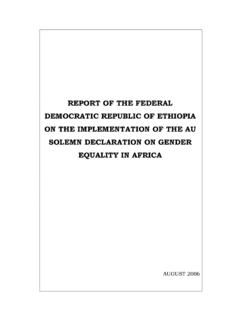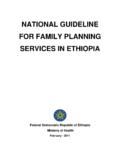Transcription of Civil Society, NGOs, and Development in Ethiopia
1 Civil Society, NGOs, and Development in Ethiopia A Snapshot View The World Bank Jeffrey Clark 1818 H Street Washington, 20433 USA. Telephone: 202-477-1234. Facsimile: 202-477-6391. Telex: MCI 64145 WORLDBANK. MCI 248423 WORLDBANK. Internet: E-mail: NGO and Civil Society Unit Social Development Department Facsimile: (202) 522-1669. E-mail: Internet: Civil Society, NGOs, and Development in Ethiopia A Snapshot View Jeffrey Clark The World Bank Washington, Copyright 2000. The International Bank for Reconstruction and Development /THE WORLD BANK. 1818 H Street, Washington, 20433, All rights reserved Manufactured in the United States of America First printing June 2000. A free publication. This document was prepared by the NGO and Civil Society Unit of the World Bank's Social Development Department. It is not a formal publication of the World Bank. It is being published informally and circulated to encourage discussion and comment within the Development community.
2 The findings, interpretations, and conclusions expressed in this paper are entirely those of the author(s) and should not be attributed in any manner to the World Bank, to its affiliated organizations, or to members of its Board of Executive Directors or the countries they represent. Copies of this paper are available from: NGO and Civil Society Unit Social Development Department The World Bank 1818 H Street, Washington, 20433 USA. Fax: (202) 522-1669. E-mail: Internet: Cover designed by Melody Warford, Stone Soup, Inc. Cover photo credits: top and bottom photos, Curt Carnemark; middle photo, Melody Warford, Stone Soup, Inc. The text and cover are printed on recycled paper. Contents Acknowledgements v Executive Summary 1. Overview of the Emerging Civil Society 1. Purpose of the Paper 2. Portrait of the NGO Sector 4. Historical Brief 4. Emerging Civil Society 5. Relief-to- Development Shift 6. Critical Civil Society Actors 7. Building Capacity for NGOs 9.
3 Networks and Coalitions 10. Code of Conduct for NGOs in Ethiopia 11. Legal and Regulatory Framework 12. The Public Policy Advocacy Role of NGOs 13. Challenges for the NGO Sector 13. The World Bank and NGOs 15. Civil Society, Development , and Democracy 15. NGO Priorities and Official Development Agendas 16. Dialogue on Partnerships in Development 16. Notes 18. Annex A: Timeline 19. Annex B: Selected Bibliography 21. iii Acknowledgments This paper was written by Jefferey Clark, International Siddiqi for the management of the project, and Yumi Development Consultant, for the NGO and Civil Society Sera and Lina Abirafeh for their editorial support. Unit of the World Bank's Social Development Department. He relied on the support of countless persons who offered William Reuben their assistance by providing information and sugges- Coordinator tions. We would like to especially thank the Ethiopia NGO and Civil Society Unit country Team for their encouragement and advice, Najma v Executive Summary Overview of the Emerging Civil Society barely existed.
4 Other Civil society entities had fared no better as professional associations, trade unions, the media, academia, the private business sector, and the History of Ethiopian Civil Society like were ruthlessly suppressed by the Mengistu regime,3. Eight years into Ethiopia 's uneven but continuing move and their leaders forced into exile, imprisoned, or toward representative democracy, the country 's non- executed. governmental sector struggles for definition, operating space, and enhanced institutional capacity. Civil soci- Progress Since 1991. ety, traditionally weak in Ethiopia , remains underde- veloped and somewhat misunderstood in the current By any measurement, the progress realized since 1991. era of relative political liberalization. The historical cen- is impressive. Civil society is increasingly vibrant and tralization of power in Ethiopia has left long shadows, relevant to the nation's political and economic revital- and the impulse to extend strict and at times arbitrary ization.
5 The private business sector is growing, acade- authority over various Civil society entities remains mic freedom is returning to the institutions of higher embedded in the psychology of some officials. Many in learning, the media are slowly gaining credibility, and government seemingly see Civil society actors by defi- professional associations are again forming. Most sig- nition as political opponents indeed, as part of the nificantly for this study, the number of NGOs specif- partisan opposition despite a decidedly nonpartisan ically, the number of national, indigenous NGOs is orientation by the vast majority. growing, and the capacity of those groups to play a serious role in addressing the country 's complex devel- opment agenda is measurably expanding. By 1998, some Society is alive again in Ethiopia ! 240 national and international NGOs were officially reg- veteran Ethiopian observer istered with the government, and a large number of additional groups awaited the recognition status offered through the registration process.
6 The pace of registra- Ethiopia 's long history as a feudal monarchy and its tion continued to accelerate into 1999, with the best subjugation by a brutal and doctrinaire Marxist regime available count of registered NGOs now being 310. have left most structures of Civil society stunted. Indeed, Further, there has been notable progress in the ability by the time the Derg1 collapsed in 1991, virtually all of the national NGOs to strategically target and design Civil society entities had been co-opted or barred from activities, credibly deliver critical services, and provide meaningful existence by the The NGO (non- accountability on programming and expenditure of funds. governmental organization) sector then primarily com- prised two significant groupings: international relief Main Concerns agencies, tolerated by necessity by the government, and the humanitarian wings of the opposition groups oper- Problems remain. Compared with countries elsewhere ating beyond the government's reach.
7 Authentic nation- in Africa, the NGO sector is small. Its operating capac- al NGOs (beyond small, church-affiliated agencies) ity, while expanding, remains too limited, and the geo- 1. 2 Civil Society, NGOs, and Development in Ethiopia : A Snapshot View graphical focus of NGO activities is noticeably confined by the government. The sophistication of sector lead- to Addis Ababa. The enabling environment in which ers as they strive to define NGOs' operating space and NGOs operate is replete with excessive regulation and improve the enabling environment for their members bureaucratic requirements that consume much valu- is notable. The more thoughtful and careful donor agen- able time. Too many international NGOs and donor cies are beginning to seek NGO inputs to national devel- agencies remain only rhetorically committed to serious opment schemes and not just in implementing but efforts to build the institutional capacity of national conceptualizing aspects of proposed interventions.
8 NGOs. The sector suffers from internal divisions and jealousy that at times preclude cohesion around impor- tant public policy issues. The public and the national Purpose of the Paper media remain somewhat vague on the whole concept of private and voluntary action by Civil society actors. This paper provides a quick overview of the potential role of NGOs and other Civil society actors in meeting Ethiopia 's immense Development challenges as the coun- Recently, I have noticed that Civil society members, including try moves to institutionalize fundamental changes in NGOs, are being consulted on policy discussions on topics like governmental structure and economic orientation. Those human rights, family law, and ethics in government. These are healthy signs that were unthinkable just a few years back. changes frame the country 's transition from absolute authoritarianism and a command economy to an evolv- Ethiopian NGO official ing democracy and economic liberalization.
9 By defini- Positive Impact of Civil Society Box 1: A Quick View of Ethiopia Despite these difficulties and others, NGOs represent Official name of country an important element in the political and economic Federal Democratic Republic of Ethiopia transformation of Ethiopia sought by its people and gov- Population ernment and supported by the international donor com- million munity. In an immediate sense, NGOs provide relatively Territory efficient mechanisms for addressing poverty allevia- 1,127,127 square kilometers tion through myriad programs and activities being Comparative area slightly less than twice the size of Texas launched in vital sectors of society. As important, they GNP. provide channels for involving self-motivated groups US$ billion and skillful individuals in the nation-building and soci- GNP per capita etal Development processes. These are the actors who US$110. can serve as anchors for Civil society in a pluralistic Population growth rate system of governance.
10 Percent Life expectancy at birth 50 years Recent Improvements Infant mortality rate 107 per 1,000 live births There is a sense that the overall operating climate for Child malnutrition rate NGOs is improving. Relations with the central and 48 percent of children under 5 years regional governments are better, if still uneven. The Illiteracy 65 percent of population above 15 years emergence of a coherent NGO sector is now more appar- Number of NGOs officially registered (1999). ent. Measurable improvements in the capacity of its 310, of which 120 are international entities members are manifest. The shift in emphasis from relief Note: All figures (except NGO count) are for 1997. to long-term Development on the part of NGOs has Source: World Bank 1998, Ethiopia at a Glance. increased their relevance and, significantly, acceptance Executive Summary 3. tion, this overview cannot explore all of the complica- Terminology tions and factors that effect the growth of Civil society The terms Civil society and the NGO sector are not inter- and the NGO sector during this transitional era.


















